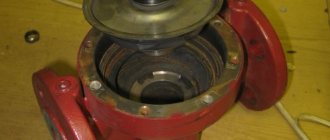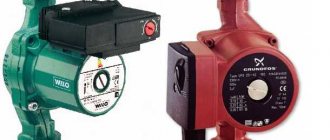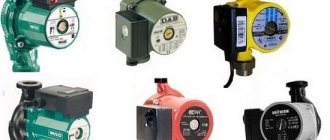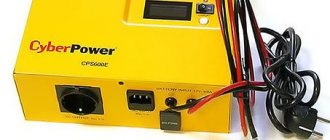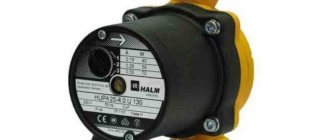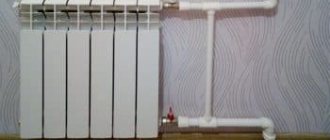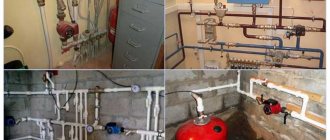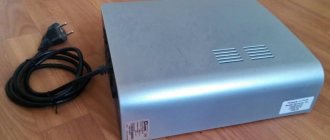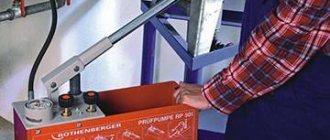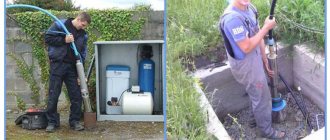Every person who uses electric heating in their home has encountered the fact that at the most necessary moment it may turn off. This problem is solved by uninterruptible power supplies - sources of electricity that work even when the full power supply is turned off. It is quite possible to not only purchase a UPS for heating systems in a store, but also make it yourself for your home, cottage or apartment, and below we discuss in detail how to do this.
Causes
The pressure in the system is to blame: with natural circulation it does not exceed 0.6 mPa, and this is not enough to provide heating for a multi-story or just a large building. To increase pressure and improve water circulation, you need to either create a closed system using larger diameter pipes, or build in a circulation pump.
Since reconstruction using larger diameter pipes is not a cheap procedure, the best solution in this case is a circulation pump.
Operating principle and device
All circulation pumps have one goal - to start forced circulation of water in a closed heating system. Their structure resembles the structure of a drainage pump, and the body is made of an alloy or metal that is not susceptible to corrosion. It can be bronze, brass, cast iron, steel or aluminum. The pump is equipped with a rotor and an electric motor. The rotor shaft is made of steel or ceramic and has a blade wheel - an impeller. The electric motor drives the rotor.
After installation in the system, the circulation pump, through the use of centrifugal force, sucks in liquid from one side and pumps it out from the other. The rotation of the impeller creates centrifugal force. If the pump operates evenly, the water level in the tank will be static. It turns out that one such pump is not enough to increase the pressure and improve heating.
It is in this case that it is necessary to connect circulation equipment. It will help the fluid overcome the resistance that arises in different parts of the system.
So, if there is no circulation pump, this leads to increased fuel consumption for heating and increased costs.
Solutions
You can get around the problem of power outages by simply installing larger diameter pipes into the existing system. The liquid in this system circulates naturally - due to the force of gravity. However, such a system is not convenient to regulate.
You can also use a generator. However, the generator requires special operating conditions: maintaining the same fuel level and having a special place. All this, as a rule, requires finance, and besides, it is unsafe. During operation, there is a possibility of power surges, which can lead to breakdown of the electronic control system of the boiler.
It is much more convenient and easier to solve the issue using a UPS - an uninterruptible power supply. “Uninterruptible power supply” automatically turns on when there is no power, so the system will work in any case. UPS equipment can be installed in any room without any special maintenance - the batteries are replaced every 2-3 years. This device operates almost silently. It should also be noted that installing a UPS is much cheaper than buying, for example, a generator.
Possible problems in the operation of the uninterruptible power supply
During operation of the equipment, the following malfunctions may occur:
- contamination of the internal surface of the UPS, dust settling on it (especially during construction work indoors);
- Frequent overloads in the operation of an uninterruptible power supply can lead to the inverter failing;
- the end of the battery life (with long-term use of the device);
- The special lubricant on the cooling fans may dry out, which can also cause the device to fail.
The nuances of the “uninterruptible” operation
However, there are some subtleties here too. The UPS, as a rule, produces a constant voltage, while the pump requires an alternating type of voltage. Therefore, for an uninterruptible power supply it is necessary to purchase an inverter - a kind of current converter.
An inverter is an essential component of the heating system, which will ensure the operation of the circulation pump.
Most often, a modern UPS is a mechanism consisting of an inverter and a battery (or there may be several of them). The advantages of a UPS that includes an inverter are as follows:
- a pure sinus is created, thanks to which the circulation pump functions;
- energy saving;
- the ability to increase the number of batteries used;
- automatic switching on during power outages and overall ease of operation.
Classification of “uninterruptible power supply”
There are several types of UPS:
- linear type is the simplest, it does not have a voltage stabilizer. If there is a power outage, the device automatically connects to battery power;
- Line-interactive uninterruptible power supply. It contains a simple stabilizer and from one to four batteries, the charge of which the system controls independently. These types of devices have lower internal voltage.
Introduction
The UPS of this model, in the event of a power outage, due to its circuit implementation, is only capable of de-energizing the load; it itself remains turned on.
This article describes how to resolve this issue. The device described here can be used with any Back-UPS model, but if you do so, the communications port information provided here may not be correct.
Overview of UPS, Communication Port and Interface Cable 940-0020B
The APC Back UPS 600I uninterruptible power supply has a StandBy (Off-Line) topology - fig. 1.
Rice. 1. StandBy topology
A UPS built according to this scheme is often called “Off-Line UPS”. At any given moment, it can be in one of 2 operating modes - Stand-by or On-line. In the case when the voltage in the network is within acceptable limits (Standby mode), the transfer switch is switched to the flow of load current through the “Surge suppressor - Filter” circuit. In this mode, the UPS is no different from an ordinary network filter. No voltage stabilization occurs. While operating in this mode, the UPS batteries are also charged.
If the network voltage goes beyond acceptable limits, the transfer switch switches to powering the load via the “Battery - DC/AC inverter” circuit (On-line mode), i.e. from the energy of the storage battery, converted by the inverter to AC 220V. Since contact switching and inverter startup cannot occur instantly, power supply to the load will be interrupted for some time (Transfer Time). Most Standby UPS provide Transfer Time of about 4-8 ms. The peculiarity of this system is that switching to On-Line when the mains voltage goes beyond the permissible limits occurs immediately, and the return to Standby mode occurs with a mandatory delay of several seconds. Otherwise, with multiple voltage surges in the network, there would be a continuous switching of Standby/On-Line and vice versa, which would lead to significant distortions of the load current and possible failure of the load or malfunction of its operation.
It should be taken into account that this circuit usually does not have the ability to stabilize the voltage when operating in Standby mode and, therefore, switches to On-Line whenever there is a network voltage deviation. The battery discharges much faster than the reverse charge. The power of the battery charger for this circuit is usually chosen to be relatively low, and does not compensate for the energy consumption from the batteries during brownouts. Therefore, for use in cases of low quality power supply network, this UPS topology is of little use for two reasons:
- a) With frequent transitions to On-Line, the battery discharges quite quickly, not having time to restore the charge during Standby mode, as a result of which the UPS loses the ability to provide emergency power to the load for the required time;
- b) Frequent repetition of discharge/charge cycles shortens the service life of rechargeable batteries.
The description of the topology is taken from (see the list of sources used at the end of the article).
Communication port
The UPS has a communication port (Fig. 2) for communication with the COM port of the computer.
Rice. 2. APC Back UPS communication port
Purpose of the port legs:
- 1. Shutdown UPS. When powered by battery, high RS-232 voltage causes the inverter to shut down and de-energize the load. The UPS responds to this signal only when the load is powered by the battery. The APC website states that the signal must be active within 1 second, but experimental testing has shown that UPS responds to the signal immediately.
- 2. Line Fail. In RS-232 levels. A high level means switching to battery power.
- 3. Line Fail. Open collector. Normally open.
- 4.GND
- 5. Battery Low. Open collector. Normally open.
- 6. Line Fail. Open collector. Normally closed.
- 7. Not used.
- 8. Not used
- 9.GND
The high level of RS-232 is about +12V relative to port ground, the low level is about –12V.
Note: when developing any intermediate circuits, TTL levels can also be used. UPS and COM port respond normally to them.
Information about the port layout and the purpose of its contacts is official, taken from (see the list of sources used at the end of the article).
Installation
The procedure for installing a UPS with an inverter depends directly on the device model. The difference between such 12/220 voltage converters lies in the type of automation, which determines the installation process.
Thus, some units are mounted directly on the motor of pumping equipment. Another type of uninterruptible power supply is wall-mounted only and only operates in a vertical position. There is also an uninterruptible power supply of rectangular shape and impressive size. This type of automation is installed next to the circulation device. You can connect the 12/220 voltage converter yourself, using the instructions.
Houses and apartments located outside the city limits use their own water heating for heating. A pump is used to pump liquid. When the electricity is turned off, the circulation of water stops, and this threatens to rupture the boiler. If residents are at home, they themselves can open the tap to bypass the flow of water, but when they are not there? Therefore, they increasingly began to use (UPS) for the heating circulation pump.
Read also: DIY tulip hdmi cable
UPS assembly
What happens if there is a power outage?
Let's simulate a situation - a power outage. First, let's consider short-term outages, for a period of 0.5 to 2-3 seconds.
If the electricity, as they say, “flashed”, or a short-term voltage failure occurred, then all equipment in the boiler room is de-energized for this time:
- boiler TT controller (if available),
- TT boiler burner (if equipped),
- circulation pump.
After power is restored to the network, the circulation pump continues to operate, and restoration of operation of the boiler controller and its burner depends on the specific model of boiler equipment.
In such a short period of time, nothing terrible happens; when the circulation pump is turned off, the fuel in the firebox continues to burn, including in pellet boilers. No pellet supply, no air supply. If it is impossible to restart the “brains” of the boiler and burner, the pellet boiler will go out.
The wood and coal boiler will continue to burn fuel in the firebox, and after power is restored, the circulation pump will work again. The outlet temperature will not have time to rise to critical in 30 seconds.
If the voltage in the network goes out for a longer period, then options begin. A pellet boiler, as well as any other boilers with automatic power supply, will gradually go out - the fuel supply does not work, the fan does not work.
In the case of using a Pelletron burner or a Pelletron boiler, an emergency shutdown of the supply of pellets from the hopper will operate.
But for solid fuel boilers using wood and coal, the situation will be much worse. When the circulation pump is not working for a long time, the outlet water temperature will rise to the boiling point, as the fuel in the firebox continues to burn. Boilers with a mechanical thermostat, such as Viadrus or Buderus, will be able to “stifle” combustion by limiting the air supply, but will not completely stop combustion.
In case of neglect of SNiP and NPB, in the absence of a safety group, we have not only a boiled boiler, but also a boiled maintenance system, and, as a result, a local explosion of superheated steam at the weakest point of the system.
If the heating system is open with natural circulation, then this, of course, does not happen.
However, fewer and fewer houses are being built in which CO with EC is used. More and more CO with closed forced circulation.
Can a fire occur in the boiler room if the electricity is cut off? No. Almost all modern boilers are equipped with mechanical draft regulators, which will prevent the fuel from actively burning if the set coolant temperature is exceeded.
Operating principle and design of the UPS
The name itself shows the purpose of the device - to provide uninterrupted power supply from a reserve when the main source is turned off. The first uninterruptible power supplies appeared after the creation of computers and were intended to maintain high-quality power supply and short-term continuation of work after the main power was turned off. The UPS filters the incoming voltage, and if it does not meet the required parameters or disappears, it automatically supplies power to the consumer.
The UPS consists of the following main components:
- power switching system (bypass);
- Charger;
- DC to AC converter;
- governing body;
- battery.
Internal Components
A switch is needed to switch the voltage source. The working element can be a power relay (in cheap models), thyristors, and recently IGBT transistors have begun to be used. The response time ranges from 6–10 ms. The ability to switch a current of a certain power affects the power of the entire device. In interactive circuits, the commutator is also used to switch the terminals of the autotransformer windings.
The charger unit converts the input AC voltage into a rectified voltage of the required value to charge the battery. This device will determine which batteries can be charged.
Carefully! When choosing a battery, it is important to know its charging current; usually it is 1/10 of the capacity; if it exceeds the capabilities of the device, the battery will not charge.
The conversion of the battery's direct current into alternating voltage is carried out by an inverter. It is he who is responsible for the voltage quality and power of the UPS. The battery is the source of energy for such a conversion, and its capacity will determine how long the uninterruptible power supply can provide energy to consumers.
Schematic diagram
Electrical components, buttons, and switches act as the control body. LCD screens can be used for visual control. According to the principle of operation of UPS for heating there are:
- reserve;
- interactive;
- double conversion.
To understand what is their difference, it is worth analyzing each circuit; in the future, this will help solve the question of how to choose a UPS?
Reserve
The simplest circuit uses a simple filter at the input that can delay high-voltage and electromagnetic pulses; it is made in the form of a capacitor (C) or a coil and capacitor (LC). The load is connected directly to the network. If the power quality deteriorates significantly or if it disappears, the supply voltage is supplied from the UPS. Used in simple and cheap models. Often used to power computers, it has a high efficiency of about 99%.
Appearance of a computer UPS
The disadvantage is the complete lack of ability to change the voltage amplitude and frequency of the mains current. The inverter circuit is simplified as much as possible, which leads to distortions in the shape of the sine wave. Instead of a sinusoid, as a rule, there are rectangular signals. They are not dangerous for the computer, since the current is immediately rectified.
Important! Asynchronous motors used in pumps can only operate normally with the correct sine wave; if low-quality energy is supplied, they will function poorly and quickly fail.
For lighting and heating devices, the signal shape does not matter.
Linear interactive
This circuit is more suitable for an uninterruptible power supply for all heating system pumps. The main difference from the previous circuit is the ability to change the input voltage. To do this, a transformer is installed in the input circuit, the primary winding of which has several terminals; it acts as a stabilizer.
At rated voltage, no adjustment is made, and if the balance is disturbed, additional turns are automatically connected or disconnected. This stepwise switching allows the battery to be used less, which significantly extends its life.
Interactive UPS diagram
The inverters used produce rectangular, trapezoidal, step or sinusoidal voltage, it all depends on the complexity of the device. Naturally, this affects the cost.
Inverter
The inverter or double conversion circuit is very different from the previous two. There is no direct connection of the load to the network, but the connection occurs according to the following scheme: the network voltage passes through a surge filter, a rectifier, after which part of the energy, if necessary, goes to charge the battery, and the rest goes to the inverter, is converted into alternating current and goes to the consumer.
Appearance of the inverter UPS
A fully automated system capable of controlling amplitude and frequency, the output signal shape is as close as possible to a sine wave. When the mains power is turned off, the UPS continues to operate from the battery, which has virtually no effect on the output signal.
Testing the device under load
Now that the device is assembled and we know how it works, we need to remember what we can power from it.
The most important thing is to remember what current consumption this device can provide. In the circuit I use a 3A converter. The discharge current of an 18650 battery is usually equal to two times the capacity (if we do not consider high-current ones). Thus, when using a battery with a capacity of 2000 mA, they are capable of delivering current up to 4A. However, it is worth remembering that if we doubled the output voltage on the DC/DC converter, for example, we power the equipment from 24V with a current of 1A, then the current to the converter will also double and the batteries will supply a charge with a current of 2A.
Accordingly, it is better to remember this pattern:
- 12V – 3A
- 24V – 1.5A
- 48V – 0.75A
We carry out a load test and determine the battery life.
The UPS is equipped with a 2000 mA GoPower battery. Output voltage – 12V. There are 3 devices connected to the UPS - hEX PoE to which, in turn, CSS106-5G-1S and 951Ui-2HnD are connected via PoE-out. Traffic on the network continues to run when the input power is turned off.
In total, the total consumption of all devices was about 0.55-0.65A (changed during the measurement process). CSS106-5G-1S – ±185mA, 951Ui-2HnD – ±280mA plus own consumption hEX. Before shutting down, this assembly worked for 2 hours 15 minutes
, while the residual voltage on the three batteries was 6.5V. It was not possible to discharge more strongly; the deep discharge protection on the 3S module worked. The temperature of the batteries did not change, which indicates an insignificant load during the discharge process.
Advantages and disadvantages of different types of UPS
We can sum it up. UPSs with a backup power circuit are easy to use and lighter than their counterparts. Since the electrical circuit is cooled naturally, it does not produce noise. If you compare the price level, they are the cheapest. However, for all their attractiveness, they have a very significant drawback - they are not able to provide high-quality power to asynchronous motors.
Interactive uninterruptible power supplies, thanks to the built-in transformer, are able to control the amplitude of the input voltage. True, in simple models the adjustment is limited to 1–2 steps, producing larger changes in the signal. More complex types have the ability to lower the voltage, and installed filters improve the quality of power from the network.
The inverters used on expensive models produce a signal close to a sine wave, which allows the use of such UPSs to power a circulation pump. Compared to backup ones, these are more expensive models.
Read also: Assembling a power panel for 3 phases
Double conversion UPS is distinguished by excellent characteristics of electrical energy supplied to the load. Better than others for reliable power supply to the pump. The disadvantages are low efficiency (80–94%) and high price, approximately 2–3 times higher than previous types.
What are there
All produced blocks can be divided into three types:
- Reserve. USP low power. The main function is to switch to battery power during network failures and vice versa when the voltage normalizes;
- Interactive. They are most often used for home and office computers. The device has a stabilizer that produces a sinusoidal voltage at the output;
- Online power supplies. During their operation, double voltage conversion occurs. The input alternating current is converted to direct current, and the inverse converter converts it back to alternating current. Used when operating large DNS servers and stations.
In medium and high power units there is a special device for connecting input and output directly, without using backup power, which is called bypass. During overloads, power from the inverter is sent to the bypass, which saves current consumption.
Correct selection of a block includes selection according to power, type and intended use.
Criteria for selecting a backup power source
When the question arises of which uninterruptible power supply to choose for a heating pump, here's what you should think about. How often is power cut off and for how long? Will anything else be powered by the uninterruptible power supply? What is the quality of the supplied energy? How much money can be spent on a UPS? Some may find it necessary to consider certain models or manufacturers. Already at the point of sale, you will have the opportunity to pay attention to the design and color, dimensions and weight of the future purchase.
Determining the required UPS power
To determine the power, it is decided which consumers will be connected. In the passports of these devices, they find the required indicator and add it up. Modern UPSs have a power reserve for starting engines; this is usually indicated in the data sheet. The duration of peak loads is short, but this is quite enough to start the pump. Usually there is no need to start it, since the automation works quickly and the pump continues to spin.
Battery capacity
The operating time of the UPS directly depends on the energy stored in the battery. It would seem that the larger the battery capacity, the better, however, there are pitfalls here.
Note! The rectifier designed to charge the battery has a current limitation.
What current the charger is designed for must be indicated in the document or on the UPS itself. You can select one battery or several for this current. If several are selected, the charging current of each battery is summed up. Some people still purchase such batteries, but charge them separately through an additional rectifier.
Batteries are divided into two groups:
Starters are able to quickly release a charge, but after that they need to be charged as quickly as possible. An example is batteries on rolling stock. Their difference lies in the presence of filler holes with plugs, through which water or acid (alkali) is added. They cost much less than traction ones, so they attract attention.
Starting battery
When installing such batteries, it becomes necessary to monitor the density of the electrolyte. They can be placed in non-residential premises, away from heating boilers. The life of the batteries will directly depend on how long they are left in a discharged state.
Traction batteries, on the other hand, are specially designed to withstand prolonged discharge. They do not need to be monitored for the presence and density of the electrolyte; they can be installed in residential areas and operate at high temperatures. The disadvantage is the high price.
Traction battery
Input voltage
In the case when the UPS is made according to a backup or interactive scheme, the input voltage, if available in the network and meeting the permissible characteristics, is directly supplied to the load. In the second circuit, the voltage can be regulated within a fairly wide range; in the first case, it is not regulated at all. Small voltage surges of short duration are damped by capacitors.
Output voltage and its shape
The output voltage is more stable due to a constant source and a constant load, but the shape, with the exception of the inert circuit, differs from the sinusoidal one. This is explained by the operation of the electronic key on which the frequency generator is made. The key transistors are in two positions: on, off. Therefore, the waveform is rectangular. By adding smoothing capacitors it can be slightly changed, transforming it into a trapezoidal one. More complex circuits make it possible to achieve an approximate sinusoid shape, but they are more expensive.
Rice. 9. Sinusoidal and trapezoidal current
Why did I think about this?
I live in a private house and my work is 100% dependent on the availability of the Internet.
But it just so happened that in our area of the Leningrad region the situation with energy supply is very sad. Quite frequent outages due to sudden changes in weather, worn out high-voltage lines coming to us, and so on. Accordingly, in the event of a power failure, the entire network infrastructure falls and until everything rises, all routes are restored (OSPF) at least 2-3 minutes will pass. It is also worth remembering the danger of such outages for the equipment itself. It takes approximately 5-10 minutes to start and connect the backup power source (generator). In this situation, UPS is not a luxury - it is necessary like air.
My network infrastructure is built on MikroTik equipment, it is simple but there is quite a lot of it:
- 951Ui-2HnD is a border router into which the Internet from Cambium “comes” (radio bridge to the MTS BS), it also protects the network and has a VPN server for remote access.
- hEX PoE – acts as a local network router and CAPsMAN controller.
- CSS106-5G-1S – in the server cabinet
- 3 pieces hAP Lite – Wi-Fi access points for seamless roaming. There are many of them, they are scattered throughout the territory and all at low power. Used only for mobile devices and smart home.
- OmtiTik5ac PoE and SXTsq Lite5 – radio link to a second home
- BaseBox2 – outdoor access point.
It is not possible to power all this from one classic UPS - the equipment is scattered throughout the territory. Secondly, under my conditions, the battery inside a classic UPS dies in about 1.5 years, and the cost of a new battery is quite high.
UPS models
In the trading market, ratings of UPS models are constantly changing, but some can be paid attention to. Russian UPS Energy PRO-500 is an inverter with high stabilization (5% at the input and 1% at the output). Produces a pure sine wave, battery charging current is 20A, and has overcharge protection. Built-in automation protects the battery from excessive discharge, which extends its service life and prevents short circuits. There is a light indication and a color display.
Chinese Guarantor 500 refers to interactive UPS. Capable of delivering up to 300 W. The kit includes a 100 A/h battery, which is charged with a current of 10 A. The following video “how to choose an uninterruptible power supply for a pump” will give some more useful tips:
How to make an uninterruptible power supply for a pump with your own hands
If for some reason you need to make a UPS for an asynchronous heating circulation pump with your own hands, then you need to purchase the following components:
- inverter;
- Charger;
- battery;
- switch;
- fuse;
- wires.
When purchasing an inverter, it is important to choose a model with the most accurate sine wave shape of the output voltage. The connection diagram is shown in the video:
A properly selected UPS will allow you not to worry about the pump during a power outage and will extend its service life.
Every person who uses electric heating in their home has encountered the fact that at the most necessary moment it can turn off . This problem is solved by uninterruptible power supplies - sources of electricity that work even when the full power supply is turned off. It is quite possible to not only purchase a UPS for heating systems in a store, but also make it yourself for your home, cottage or apartment, and below we discuss in detail how to do this.
Switching power supplies - how they work - a brief overview of the circuits
The block diagram of a switching power supply is illustrated by mnemonic symbols of the voltage form above each of its component blocks, and the interaction connections are indicated by arrows.
It is convenient to represent the schematic diagram in this way.
The circuit board of one of the devices with the location of the parts is shown in the photo below with my comments.
Naturally, this is only a special case, which most likely will not coincide with your UPS. Here I have a simple goal - to recall the principles of interaction between the component parts of the block.
If you need to familiarize yourself with these issues in more detail, then read the specially written article.
What will you need?
If you are making an uninterruptible power supply for a gas boiler or for a heating circulation pump with your own hands, then one of its most important parts is the inverter .
An inverter is a device that converts the direct voltage of a battery into an alternating voltage of 220 V. It is clear that the uninterruptible power supply itself is better made from rechargeable batteries; they are much cheaper than various generators.
In order for the boiler, which is dependent on electric current, to function normally, it is best to install CPS type inverters (the best index options are 3500, 7500 and 5000 PRO).
In addition to the inverter, you also need the batteries themselves, which provide uninterrupted power for the boilers/pumps, as well as a charger.
Self service
If you managed to assemble a UPS for the boiler with your own hands, then servicing it is often not difficult . You will only have to change the batteries at certain intervals and periodically check the integrity of the entire system.
It is better to install the UPS either in the basement or semi-basement so that it does not occupy the space of the apartment, but moisture penetration, of course, is unacceptable in any case, so placing it in a small closet would be a good option.
Watch a video on this topic
Step by step instructions
The choice of inverter was mentioned earlier .
Batteries are selected with the largest capacity - the larger it is, the longer the uninterruptible power supply will last. If the equipment capacity is 45 ampere-hours, then it will operate for 8 hours, but at 95 ampere-hours it will operate for up to 24 hours.
The charger must match the battery capacity.
If you purchased a ready-made inverter, batteries and charger, then all that remains is to do the following :
- Connect the two symbols “+” and “-“, which are marked on the UPS inverter for a gas boiler, to each other with a powerful wire with similar marks on the battery.
- Insert the boiler plug into the inverter.
- Click "Enable". That's it, the device is working.
But, of course, not everything is so simple, and the following nuances should be taken into account :
- It is better to use thick and copper wires for connections;
- The places where these wires are connected to the devices must be extremely reliable - this should be carefully monitored;
- The connections should be checked in the future, because there is a risk of metal oxidation and deterioration of the system.
More details about what else is important to consider are in the next section.
What to look for?
Most modern heating systems use methane as fuel. But for the system to operate stably, it must have a current source that produces continuous voltage without any interruptions. If the power supply is abruptly turned off, the coolants will gradually cool down, and this is very unpleasant, since cracks may eventually appear on them in some places - first small, and then larger.
Therefore, carefully monitor the stability of the device!
Nuances of assembling an external harmonic filter
And the so-called harmonious system for voltage filters will help us with this.
Here too, you can take the initiative and do it yourself, but it’s better to at least install and find a proven scheme first. Such filters consist of various resistors, transformers and other auxiliary devices.
A properly assembled system should be guaranteed to stabilize any source of electric current.
However, the circuit of such a filter is simple, it can be seen below .
The main difficulty here lies in calculating the parameters. The circuit elements are calculated and made identically, only they are assembled in different ways - one is serial, the other is parallel, but in both cases they are tuned to a frequency of 50 Hz.
It is necessary to calculate the parameters of the inductors for the available core.
You will also need to make a gap between the turns in the core.
The formulas for calculating the parameters are as follows:
- Clearance in millimeters = 1.257E-3 * max. current in amperes * number of turns.
- Number of turns = 1.257E6 * max. current in amperes * inductance of the inductor in H * cross-sectional area of the core in square millimeters - round the result up
- For a series circuit: the maximum current in amperes is 1.4 * <load power, W>/ 220 V.
- For a parallel circuit: the maximum current in amperes is 1.4 * 220 V/ 28 * <signal frequency, Hz – 50 Hz>* < inductance of the inductor, H>.
Precautions and possible errors
- First of all, if you decide to make an uninterruptible power supply for a heating pump with your own hands, you need to wear gloves so as not to receive an electric shock from exposed wires or contacts.
- You should carefully examine the wires - they should not have even slight damage, because... A short circuit is very dangerous and can not only harm human health, but also cause a fire.
- For the system, you should connect several batteries (it is best to take 2-4 fully charged ones) and connect them in parallel.
- In no case should you save money and buy cheaper devices, since the quality and service life usually correspond to the price.
- Do not connect everything to the device; use it exactly for those devices for which it is designed for its power. However, for computers, as a rule, this power is quite enough, the main thing is that the total power does not exceed the maximum permissible.
- The best choice, as experts advise, would be models with phase-dependent equipment.
How to choose
When purchasing a UPS for a heating pump, you must consider the following nuances:
- Heating boiler power consumption. When choosing a UPS, the characteristics of the equipment with which it will work are first taken into account. To determine the power of the UPS, it is necessary to take into account the “starting torque” of the engine, since when the uninterruptible power supply is turned off, the power consumed by the engine invariably increases. If it is greater than the power of the UPS, the device will automatically stop working.
- UPS battery life. This value depends on the battery capacity. Experts advise choosing a UPS with external batteries connected. This will allow you to select the required number of batteries and ensure the required time of independent operation of the equipment. Devices with internal batteries are used less frequently because they cannot provide long-term backup power. Uninterruptible power supplies with internal batteries will ensure longer operation of the equipment in case of problems with the power supply. Models of this type are marked Long Time - “long time”.
- The time it takes for the equipment to go offline. The faster the power supply is restored, the less load will be on the main heating system.
- Output voltage parameters. They are indicated in the standard instructions attached to the device. You should choose a UPS with data - pure sine, other specified characteristics can lead to a malfunction of the entire system and even failure of the pump itself.
